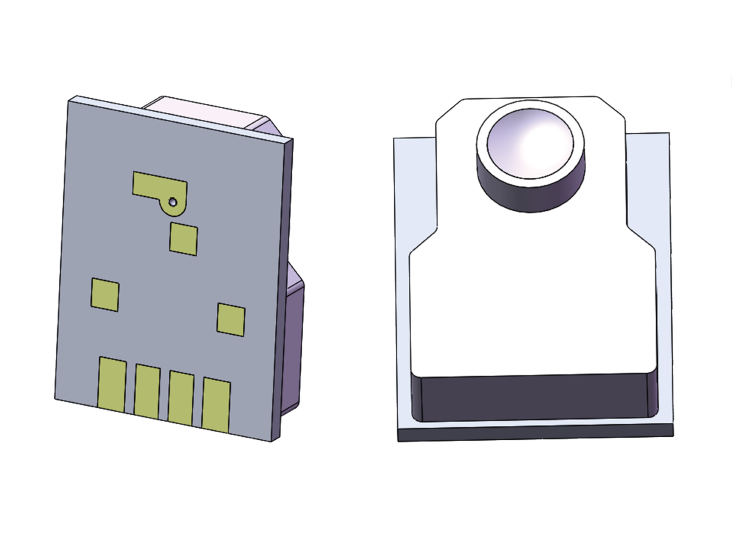Katalog
Invasive Blutdrucksensoren dienen als Kerntechnologie der modernen medizinischen Überwachung und spielen eine unersetzliche Rolle bei der Überwachung der Vitalfunktionen kritisch erkrankter Patienten. Dieser Artikel bietet eine detaillierte Analyse von MEMS-basierten piezoresistiven Silizium-Drucksensoren’ Anwendungswert in der hämodynamischen Überwachung, wobei der Schwerpunkt auf technischen Prinzipien, Leistungsmerkmalen und klinischen Implementierungslösungen liegt.
1. Kern der piezoresistiven Silizium-Sensortechnologie
Piezoresistiver Effektmechanismus
Piezoresistive Silizium-Drucksensoren nutzen einzigartige physikalische Eigenschaften, bei denen sich der Widerstand des Siliziummaterials unter mechanischer Belastung vorhersehbar ändert. Der Sensor verwendet einkristalline Siliziumwafer und eine Wheatstone-Brückenkonfiguration.
Designmerkmale der Sensorstruktur
Moderne invasive Blutdrucksensoren nutzen die Keramiksubstrat-Verpackungstechnologie und bieten mechanische Stabilität und hervorragende Temperatureigenschaften. Schützende Gelschichten isolieren effektiv Verunreinigungen und bewahren gleichzeitig die Genauigkeit der Druckübertragung.
Signalverarbeitungs- und Kompensationstechnologie
Integrierte Dickschichtschaltungen sorgen für Signalverstärkung, Temperaturkompensation und Linearisierungsverarbeitung. Unter Verwendung der Versorgungsspannung als Referenz gibt das System standardisierte Spannungssignale aus und gewährleistet so eine stabile Messgenauigkeit im Betriebsbereich von 15℃–40℃.

2. Leistungsvorteile bei medizinischen Anwendungen
Messgenauigkeit und Zuverlässigkeit
Im Vergleich zu herkömmlichen Dehnungsmessstreifensensoren weisen piezoresistive Siliziumsensoren eine überlegene Empfindlichkeit auf und erkennen kleinste Druckänderungen im Bereich von -50 bis 300 mmHg. Hervorragende Linearität reduziert die Komplexität der Backend-Signalverarbeitung.
Echtzeit-Antworteigenschaften
Die invasive Blutdrucküberwachung erfordert eine schnelle Sensorreaktion, um unmittelbare Druckänderungen zu erfassen. Piezoresistive Siliziumsensoren’ Das miniaturisierte Strukturdesign ermöglicht extrem kurze Reaktionszeiten für die Echtzeitverfolgung des arteriellen Drucks.
Biokompatibilitätsdesign
Invasive Sensoren in medizinischer Qualität müssen strenge Anforderungen an die biologische Sicherheit erfüllen. Sensoren, die aus Materialien medizinischer Qualität hergestellt werden, verfügen über Oberflächenbehandlungen, die den Biokompatibilitätsstandards entsprechen, und sind für den Einmalgebrauch mit einer Dauerbetriebsfähigkeit von 168 Stunden konzipiert.
3. Implementierung der klinischen Überwachungslösung
Erfassung hämodynamischer Parameter
Invasive Blutdrucküberwachungssysteme platzieren Sensoren über Katheter direkt in den Arterien und stellen so Verbindungen zwischen Gefäßen und Überwachungsgeräten her. Sensoren erkennen intravaskuläre Druckänderungen in Echtzeit.
Umfassende Multiparameter-Überwachung
Moderne Systeme gehen über die Druckmessung hinaus und ermitteln das Herzzeitvolumen, den peripheren Widerstand und die Gefäßcompliance durch Wellenformanalyse. Hochpräzise Druckdaten bieten eine zuverlässige Grundlage für abgeleitete Parameterberechnungen.
Automatisierte Integrationsanwendungen
Das Sensordesign berücksichtigt automatisierte Produktionsanforderungen, wobei standardisierte Verpackungsformen die mechanische Chargenmontage erleichtern. Dieser Ansatz senkt die Herstellungskosten und verbessert gleichzeitig die Produktkonsistenz und -zuverlässigkeit.
4. Technische Spezifikationen und Leistungsindikatoren
Technische Kernparameter
Die technischen Spezifikationen entsprechen strikt den AAMI-Blutdruckmessgerätstandards. Der Druckmessbereich umfasst -50 bis 300 mmHg und erfüllt die klinischen Überwachungsanforderungen bei Betriebstemperaturen von 15 bis 40 °C vollständig.
Elektrische Leistungsmerkmale
Sensoren nutzen Standard-Stromversorgungsmethoden mit Spannungssignalausgängen, was die Schnittstellenkompatibilität mit verschiedenen Überwachungsgeräten erleichtert. Das stromsparende Design verlängert die Betriebszeit, während die hervorragende elektromagnetische Verträglichkeit einen stabilen Betrieb gewährleistet.
Mechanische Festigkeitskonstruktion
Die Auswahl des Keramiksubstrats bietet hervorragende Isolierung und mechanische Festigkeit. Sensoren halten verschiedenen mechanischen Belastungen während des Transports, der Installation und des Einsatzes stand und behalten gleichzeitig eine langfristig stabile Leistung bei.
5. Qualitätskontrolle und Einhaltung von Standards
Einhaltung der Standards für Medizinprodukte
Die Produktentwicklung folgt strikt den internationalen Standards für Medizinprodukte, einschließlich des Qualitätsmanagements ISO 13485 und des Risikomanagements ISO 14971. Umfassende Qualitätskontrollmaßnahmen sorgen für Konsistenz und Zuverlässigkeit.
Kalibrierungs- und Verifizierungsverfahren
Jeder Sensor wird vor dem Versand einer strengen Kalibrierung und Überprüfung unterzogen. Die Mehrpunktkalibrierung mit Standarddruckquellen gewährleistet die Einhaltung der Genauigkeit über den gesamten Messbereich.
Rückverfolgbarkeitsmanagement
Umfassende Produktrückverfolgbarkeitssysteme führen detaillierte Aufzeichnungen von den Rohstoffen bis zum Endverbraucher, erfüllen die gesetzlichen Anforderungen für Medizinprodukte und unterstützen gleichzeitig eine schnelle Lösung von Qualitätsproblemen.
Abschluss
Invasive Blutdrucksensoren sind wesentliche Bestandteile moderner medizinischer Überwachungstechnik. MEMS-basierte piezoresistive Siliziumdesigns bieten zuverlässige Lösungen für die klinische hämodynamische Überwachung mit überlegener Messgenauigkeit, Echtzeitreaktion und Biokompatibilität, was sie zur idealen Wahl für die kritische Patientenüberwachung und chirurgische Überwachung macht.
Die obige Einführung kratzt nur an der Oberfläche der Anwendungen der Drucksensortechnologie. Wir werden weiterhin die verschiedenen Arten von Sensorelementen untersuchen, die in verschiedenen Produkten verwendet werden, wie sie funktionieren und welche Vor- und Nachteile sie haben. Wenn Sie detailliertere Informationen zu den hier besprochenen Themen wünschen, können Sie sich die entsprechenden Inhalte weiter unten in diesem Handbuch ansehen. Wenn Sie unter Zeitdruck stehen, können Sie auch hier klicken, um die Details dieser Leitfäden herunterzuladen PDF -Daten des Luftdrucksensorprodukts.
Weitere Informationen zu anderen Sensortechnologien finden Sie hier Besuchen Sie unsere Sensors -Seite.
